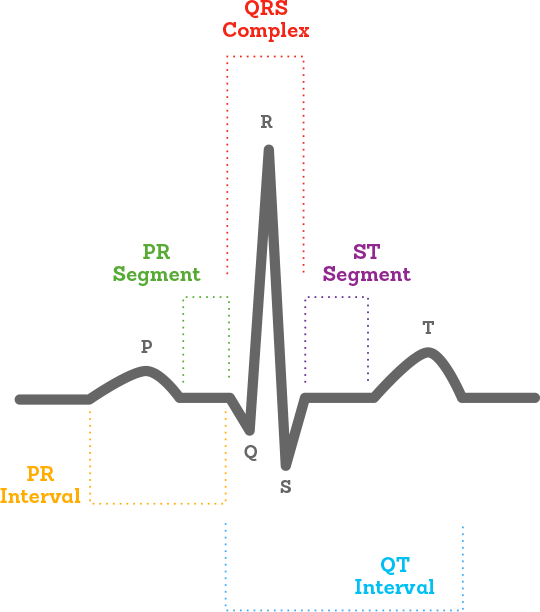Explain What the Different Ekg Waveforms Represent
V1 4th intercostal space at the right sternal edge. Correct for rate by dividing QT by the square root of the RR interval.

Intro To Ekg Interpretation Waveforms Segments And Intervals Youtube
Duration of QRS complex is 006 to 010.

. Waves are the different upward or downward deflections represented on the EKG tracing. Its the first positive waveform following P wave. Represents ventricular depolarization and repolarization sodium influx and potassium efflux V3 V4 or lead II optimize the T-wave.
The diagrammatic representation of a standard ECG is shown below. The first little hump or bump you see is known as the P-wave. Learn vocabulary terms and more with flashcards games and other study tools.
The PR interval represents the atrial depolarization and physiological delay of the stimulus in the atrioventricular AV node. 1 small box and 13 the height of the R wave in that lead. The different waves that comprise the ECG represent the sequence of depolarization and repolarization of the atria and ventricles.
Represents atrial depolarization which causes contraction as the electrical impulse spreads from the SA node through the atria usually 008 to 010 second. The P R and T waves are above the base line and are known as positive waves. It is measured from the beginning of the P wave until the beginning of the Q or R wave.
V4 5th intercostal space in the midclavicular line. The P-wave is of atrial origin while the Q R S and T-waves are of. The Q and S-waves are below the base line and are known as negative waves.
A typical human electrocardiogram has five waves P Q R S and T. The P wave represents the normal atrium upper heart chambers depolarization. ECG is often used to detect problems in heart.
P Q R S T corresponding to different phases of the heart activities. The PR interval is the distance between the onset of the P-wave to the onset of the QRS complex. A wave that is travelling towards the positive lead will inscribe an upwards deflection of the EKG.
These are known as the ECG waves. Leads and their geometry. It is a small smooth-contoured wave and represents atrial depolarisation.
Represents early ventricular depolarization. The Q and S-waves are below the base line and are known as negative waves. The P-wave PR interval and PR segment.
The region between the P wave and QRS complex is known as the PR segment. Duration of Q wave in the limb leads is 004 sec. V3 midway between the V2 and V4 electrodes.
Represents late ventricular depolarization. Start studying ECG wavesintervals. In cases such as pre-excitation syndromes the PR interval may be shortened it.
The P-wave is of atrial origin while the Q R S and T-waves are of ventricular origin. The QRS complex one single heart beat corresponds to the depolarization of the right and left ventricles lower heart chambers. The first wave is the P wave which represents the depolarization of the atria.
QT usually less than half the R-R interval 032-040 seconds when rate is 65-90minute QT varies with rate. If it is a downward deflection it is a Q wave. This spike is called the QRS complex.
The depolarization and repolarization in atria and ventricles are detected represented by three types of waves in ECG. The P wave QRS complex and T wave are the parts of an EKG in which there are changes in voltage waves. The P wave is the first positive deflection on the ECG.
A brief period follows the P wave and represents the time in which the impulse is traveling within the AV node where. There are mainly three types of ECG peak. The T wave represents the re-polarization or recovery of the.
The P R and T-waves are above the base line and are known as positive waves. A typical human electrocardiogram has five waves P Q R S and T. Remember from the electrical conduction lecture that the SA node is responsible for this.
The PR interval is assessed in order to determine whether impulse conduction from the atria to the ventricles. This happens right before the atria contract and push blood into the. The PR interval the PR segment the ST segment and the QT interval.
Each ECG cycles consists of 5 waves. There are six chest electrodes. The P R and T-waves are above the base line and are known as positive waves.
The diagrammatic representation of a standard ECG is shown below. The Q and S waves are below the base line and are known as negative waves. The P wave represents the depolarization and repolarization of atria the QRS.
The P wave is of atrial origin while the Q R S and T waves are of. For the inexperienced one of the most confusing aspects of ECG reading is the labeling of these waves. The P-wave reflects atrial depolarization activation.
The EKG waveform comes from a measurement of surface voltages between 2 leads. The P-wave represents ATRIAL DEPOLARIZATION depolarization is a big fancy word for CONTRACTION. Electrocardiography ECG is the process by which the electrical activities of heart are recorded using electrodes placed on the skin.
As the ECG trace is recorded there are a series of upwards and downwards deflections created that represents atrial and ventricular depolarisation and repolarisation. The hearts electrical activity is represented on the monitor or ECG tracing by three basic waveforms. The P wave the QRS complex and the T wave.
If the wave immediately after the P wave is an upward deflection it is an R wave. ECG interpretation traditionally starts with an assessment of the P-wave. V5 left anterior axillary line at the same horizontal level as.
Between the waveforms are the following segments and intervals. A U wave is sometimes present. Its normal value is between 012 s and 020 s.
V2 4th intercostal space at the left sternal edge. The next area you see is a big spike. The P-wave represents the depolarisation of the atria which leads to the contraction of both the atria.
The ECG is recorded at a speed of 25 mmsec 5 large squaressec and the voltages are calibrated so that 1 mV 10 mm 2 large squares in the vertical direction. Conversely a wave traveling away from the positive lead will inscribe a downward deflection. Its the first negative waveform following the R wave.
The region between 2 waves is called a segment. They are the product of the action potentials created during the cardiac stimulation and repeated from one heart beat to another barring alterations. The three waves of the QRS complex represent ventricular depolarization.
A typical human electrocardiogram has five waves P Q R S and T. The QRS complex represents the depolarisation of the ventricles which leads to the ventricular contraction. In a normal ECG theres three distinct waves.

P A C S And The Heart And Extra P Wave Google Search Cardiac Nursing Nursing School Notes Nursing Notes

Belum ada Komentar untuk "Explain What the Different Ekg Waveforms Represent"
Posting Komentar